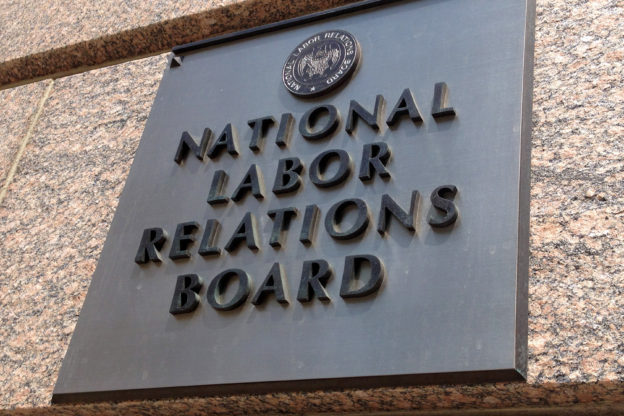By Brian Mumaugh
What is wrong with an employer’s dress code that prohibits clothing that displays vulgar or obscene phrases, remarks or images which may be racially, sexually or otherwise offensive as well as clothing that displays words or images that are derogatory to the Company? It is overly broad and interferes with employees’ Section 7 rights under the National Labor Relations Act (NLRA or Act) to engage in union and/or protected concerted activity, according to an Administrative Law Judge (ALJ) for the National Labor Relations Board (NLRB). The ALJ’s review of the dress code came after the employer disciplined an employee who wore a T-shirt with the word “slave” on it next to a picture of a ball and chain and the employee’s time clock number. Dismissing the employer’s argument that the shirt would be racially offensive to visitors who toured its facility, the ALJ found that the employer violated the Act by sending the employee home without pay to change his “slave shirt.”
The History of the “Slave Shirt”
Mark Gluch was a long time employee of automotive parts manufacturer Alma Products Company and a vigorous supporter of the union representing his bargaining unit. The 2012 incident that gave rise to this case occurred when Gluch wore the “slave shirt” to work during a period of contentious negotiations for a new union contract. The origin of the shirt, however, dated back to 1993 when company employees developed and paid for the “slave shirts” to send the company a message during an earlier round of difficult contract negotiations. The shirts resurfaced in 1996 when the bargaining unit employees wore them while picketing during a strike. Immediately following the strike, as many as 30% of the unit employees wore the “slave shirts” to work on any given Friday. No discipline or policy infraction was noted or enforced at that time.
Company Seeks to Avoid Racially Offensive Shirt
When a new president and CEO, Alan Gatlin, took over for Alma Products in 2005, he noticed employees wearing the “slave shirt.” Finding the shirts to be racially offensive, he felt embarrassed that customers and visitors to the facility would see employees wearing the shirt and be offended. He testified that in his view, the shirts did not reflect well on the Company with customers as they tried to get new business. Gatlin asked the human resources manager to draft a dress code policy which was implemented in early 2006. The dress code policy did not specifically reference the “slave shirt” but included general prohibitions against clothing that displayed “vulgar/obscene phrases, remarks or images which may be racially, sexually or otherwise offensive and clothing displaying words or images derogatory to the Company . . .” The policy also stated “[i]f you are uncertain whether an article of clothing is appropriate under this policy, follow the old adage of better safe than sorry and refrain from wearing it at work.”
After implementing the dress code in 2006, it appears that employees seldom wore the “slave shirt” to work. However, during difficult union contract negotiations in April 2012, Gluch and other employees began wearing pro-union shirts and pins and Gluch wore the “slave shirt” to work. Gluch’s supervisor gave Gluch the option of removing the shirt or turning it inside out so that the writing would not be visible. When Gluch refused to do so, he was sent home without pay for wearing the shirt.
ALJ Rejects Company’s Concerns About Racial Discrimination
The union filed an unfair labor practice charge claiming, among other things, that the policy and the Company’s enforcement of the policy, violated the Act. The Company argued that the shirt’s “slave” reference was offensive to African-Americans due to the history of slavery in the United States. Noting that an important buyer from Chrysler was African-American as was a new production supervisor at the facility, the Company asserted that it was entitled to discipline Gluch for wearing the racially offensive shirt. The ALJ rejected this argument, stating that the NLRB has repeatedly found employees to be protected even when they displayed messages that likened their working conditions to those of a slave. The ALJ noted that the dictionary definition of “slave” does not reference race, but instead focuses on the condition of servitude or being subject to a person or influence. In addition, given the shirt’s history that it had been worn to work over the past two decades as support for the union, the ALJ determined that it would not be seen as carrying a racial message. Moreover, the Company had a policy prohibiting racial discrimination since the 1990s, yet had failed to take any action to prohibit wearing the “slave shirt” as racially offensive prior to Gluch’s wearing of the shirt in 2012.
Key to the ALJ’s analysis of the dress code policy was its general prohibition of words or images that are derogatory to the Company. The ALJ found that the policy interfered with employees’ Section 7 activity, such as protected statements to coworkers, supervisors or third parties who deal with the Company, because it would prohibit employees from objecting to their working conditions and seeking the support of others in improving them. The dress code policy was found to be unlawfully overbroad because it prohibits all communications derogatory to the company regardless of whether the words are racially or sexually discriminatory or are protected as concerted activities under the National Labor Relations Act. In addition, by directing employees to be “safe” not “sorry,” the ALJ stated that the policy directs employees to construe the prohibition on derogatory comments such that it prohibits Section 7 activity.
Dress Code Policies That Do Not Restrict Section 7 Activity
With the NLRB (and its ALJs) striking down a variety of employer policies relating to both union and non-union employees, it is difficult to draw a bright line to determine which policies pass scrutiny and which do not. That said, employers can learn lessons from this recent decision that may help keep their dress code policy away from NLRB review. First, use specific examples of acceptable versus unacceptable attire rather than general statements that require interpretation. Second, if your workplace warrants different dress standards for different segments of employees (e.g., public-facing employees vs. behind the scenes employees), make those standards clear and justified by business necessity. Third, if you include a statement that prohibits derogatory words or images on clothing, include a statement that communications protected by Section 7 are permissible under the dress code. Finally, enforce your policy in a uniform and consistent manner, so that all dress code violations are treated similarly regardless of the employee or supervisor involved.
Disclaimer:This article is designed to provide general information on pertinent legal topics. The statements made are provided for educational purposes only. They do not constitute legal advice and are not intended to create an attorney-client relationship between you and Holland & Hart LLP. If you have specific questions as to the application of the law to your activities, you should seek the advice of your legal counsel.





